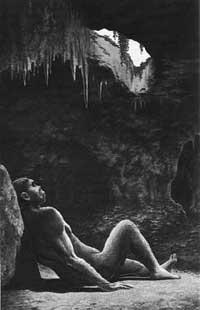Discovery of Altamura
At about sixty meters the speleologists found the human skeleton at the end of last year. The skeleton is very old, but it is in very good condition because it is protected by a layer of solidified calcium carbonate. This protection has been completed with the creation of stalagmites in the limestone by means of drops of water.

The skeleton can be male or female, but in any case it is very old; about 200,000 years ago (before the Man of Neanderthal). They call the man of Altamura because they have found Bea near Altamura, about forty kilometers south of the city. However, paleontologists around the world have endeavored to reveal a dark stretch of human evolution, corresponding to the average Pleistocene. The average Pleistocene began about 500,000 years ago and ended about 100,000 years ago with the appearance in Europe of Neanderthal Man.
The archaeology department of the University of Bari will study this skeleton and want to be very careful. They do not want to touch the man of Altamura so that he does not spoil. First, it is about studying the cave by telemetry to prevent man from among algae, fungi and microorganisms. In fact, so far many deposits have been destroyed by the presence of harmful microorganisms. The protective layer of calcium carbonate should then be removed from the skeleton with the help of experts.
The skeleton is lying and with its head turned to the left. A stalagmite has the cranial bottom crushed, but you can see the face, as it has a very thin layer of calcium carbonate. Because of the lime that has the head on it, they have not been able to measure prognatism (that like the Neanderthal man the jaws have come forward) and the volume of the brain. He has been identified with ribs, a humerus, a cubitu, a radius, a tibia and a femur. The central part of the femur (diafisis) looks strong and the head large. The skeleton is a person 1.60 or 1.65 centimeters high. It remains to be clarified whether it is male or female.
According to his first diagnosis, the skull appears to be between Homo erectus and Homo sapiens neanderthalis. It can be about 250,000 years ago, but in any case it is between 400,000 and 85,000 years. Someone will say that there is much margin, but it is the one that corresponds to that time that is unclear in human evolution.
Neanderthal Man lived mostly in Europe and emigrated to the Middle East between 130,000 and 40,000 years. We don't know how it came about. However, few anthropologists deny that Homo erectus came from Africa. It seems that after the stage of the Homo habilis after the “Lucy”, the Homo erectus arrived in Europe a million years ago. Few residues have been found in Mauer (next to Heilderberg), Petralona (Greece), Pyrenees of Tautavel, Swascombe in England, etc.
But will Homo erectus be the ancestor of the Neanderthal? And if so, what was the means? Is the Neanderthal the ancestor of modern man (i.e., the Homo sapiens sapiens en) or the Neanderthal that was destroyed by modern man? According to some paleontologists, from Homo erectus to modern man there is a single evolutionary line between Neanderthal. Others, however, consider that other human forms have existed until they reach the present Homo sapiens sapiens.
The Neanderthal Man was discovered around 1850 and a few decades later they began to consider it to be the ancestor of the present man. At the beginning of the century it was considered a line without descent of humanity, and in the sixties other opinions emerged.

However, two years ago an important discovery was made in the town of Atapuerca. In a cave a bone set of 300,000 years ago was discovered. More than seven hundred people found mixed bones. They formed skulls and the volumes corresponding to two mature men were 1,125 cm 3 (quite smaller than the present man) and 1390 cm 3 cubic (quite about 1,450 cm 3 of the present).
According to archaeologists, the skulls of Atapuerca belong to the ancient Homo sapiens, but have the first signs towards the man of Neanderthal. However, although no one knows why, the bones of the different eras of Atapuerca are mixed and the discovery of a complete skeleton in the Italian Altamura will help to better understand the process of speciation to modern man. In addition, being a complete skeleton, the relationships between the skull and the bones of the body muscle can be removed as never before.
However, in the first place, the human of Altamura must remove its calcium carbonate cover without damaging the skeleton, for which they must have the participation of scientists from various departments such as anthropologists, geologists, physicists, chemists, material experts and molecular biology personnel.





